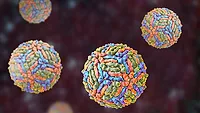Weekly Hands-on How-To powered by KnowHow
How to Avoid Bloodborne Pathogens in the Workplace
Shield Yourself from Hidden Workplace Dangers

When you think of workplace hazards, your mind might jump to falling debris or faulty equipment—but what about those “invisible” threats? Bloodborne pathogens are disease-causing microorganisms found in human blood and bodily fluids, and they can be just as dangerous as any physical hazard on-site.
Whether you’re providing first aid or handling an accident cleanup, knowing how to protect yourself is critical to staying safe. Without proper precautions, exposure to common pathogens like Hepatitis B, Hepatitis C, and HIV can lead to serious health risks. But by understanding how these pathogens are transmitted and following key safety measures, you can minimize your risk and prevent illness.
In this how-to, powered by KnowHow, we’ll break down everything you need to know about bloodborne pathogens—from recognizing transmission risks to implementing essential safety practices. By the end, you’ll have the knowledge to stay safe and protect your coworkers (and yourself!) in your workplace.
Step 1: Know the Most Common Bloodborne Pathogens
Bloodborne pathogens are infectious microorganisms found in human blood and other bodily fluids. They have the potential to cause serious diseases in humans, especially when proper safety measures aren’t followed. In occupational settings, such as construction or first aid response, exposure to these pathogens is a real risk. To protect yourself and others, it’s important to understand the primary threats you may encounter:
- Hepatitis B Virus (HBV): This virus can cause acute or chronic liver infection, with symptoms ranging from jaundice and abdominal pain to long-term liver damage.
- Hepatitis C Virus (HCV): Often transmitted through direct blood contact, HCV can lead to chronic liver disease, cirrhosis, and liver cancer if left untreated.
- Human Immunodeficiency Virus (HIV): HIV weakens the immune system by attacking key cells, making it difficult for the body to fight infections and disease. It can eventually lead to AIDS if not managed with treatment.
By understanding these pathogens and the risks they pose, you’re better equipped to take the precautions necessary to reduce exposure and prevent infection.

Step 2: Understand How Bloodborne Pathogens Are Transmitted
Bloodborne pathogens can enter your system through various exposure points. In workplace settings, transmission often occurs through:
- Needle sticks: Accidental punctures from contaminated needles.
- Human bites: Breaking the skin during physical altercations or accidents.
- Cuts and abrasions: Open wounds provide direct access for pathogens.
- Mucous membranes: Bloodborne pathogens can enter through your eyes, nose, or mouth if exposed to infected fluids.
Recognizing how transmission occurs is key to reducing your risk of infection.
Step 3: Follow These Basic Safety Principles
Once you understand the risks and transmission methods, applying proper safety procedures becomes essential. This step can be broken into three key areas:
A. Protective Measures
- Treat all blood and bodily fluids as though they are infectious.
- Avoid direct or indirect contact with anyone’s blood or bodily fluids.
- Always wear disposable gloves when providing first aid.
B. Proper Disposal and Cleanup
- Dispose of sharps (e.g., needles, razors, contaminated glass) immediately in designated sharps containers.
- Remove and dispose of gloves carefully without touching the soiled parts.
- Clean and disinfect all equipment, tools, gloves, and work surfaces after exposure to blood or bodily fluids.
C. Personal Hygiene and Follow-Up Care
- Wash your hands and any other exposed areas thoroughly after providing care.
- Avoid touching your face during or after administering first aid.
- If you believe you’ve been exposed to bloodborne pathogens, seek immediate follow-up care.
These safety protocols are designed to protect you and your coworkers from potential exposure and infection.

Invisible Hazards, Visible Solutions—Powered by KnowHow
Bloodborne pathogens may not be as obvious as other workplace risks, but they can pose serious threats if you’re not prepared. By understanding how these pathogens spread and following proper safety protocols, you can significantly reduce your exposure and keep your work environment safe.
But if you really want to take your safety protocols and team preparedness up a notch, KnowHow has you covered. With tools to quickly create and manage SOPs, thousands of restoration specific SOP templates, and instant job site support, KnowHow keeps your crew informed, compliant, and ready to respond.
Ready to strengthen your safety measures? Visit tryknowhow.com today and learn how we can help keep your team safe and compliant.
Looking for a reprint of this article?
From high-res PDFs to custom plaques, order your copy today!






.webp?height=200&t=1737149336&width=200)

